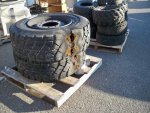The Michelin Inflation Chart shows the required pressures for each weight.
http://www.tiregroup.com/Catalogs/PDF Catalogs/Michelin.pdf Page 65 is what you're looking for. The minimum pressure listed is 65psi, however you can extrapolate the pressure for lower weights by graphing the data.
For example, the 16.00R20 LRM XZL is published to carry 13,500 lbs at 100psi (135 lbs per psi of pressure). At 85psi, it's listed as 11,800 lbs (138.82 lbs per psi of pressure). At 70psi, it's listed as 10,100 lbs (144 lbs per psi). As you can see, the amount of load per PSI of pressure increases (per the chart) as the pressure is reduced.
My truck weighs about 21,000 lbs unloaded. Given most of the weight is up front, I'd guess the front axle is about 10500 and the two rears share the other 10,500 (2,625 lbs per tire unloaded). 70psi with that little weight on each tire (and no shocks) is going to be rather bouncy.
The key would be to weigh your truck individually to determine what weight each tire is carrying. Personally, I'd add about 10 lbs from what I come up with for the safety factor and raise further from there if I added a load. Unfortunately, my CTIS says I get 70F and 70R for highway...oh well.



